check oil YAMAHA TTR50 2013 Owners Manual
[x] Cancel search | Manufacturer: YAMAHA, Model Year: 2013, Model line: TTR50, Model: YAMAHA TTR50 2013Pages: 86, PDF Size: 1.8 MB
Page 9 of 86

TABLE OF CONTENTS
LOCATION OF IMPORTANT
LABELS ............................................1-1
SAFETY INFORMATION .................. 2-1
DESCRIPTION .................................. 3-1
Left view .......................................... 3-1
Right view ........................................ 3-2
Controls and instruments ................3-3
INSTRUMENT AND CONTROL
FUNCTIONS ....................................... 4-1
Main switch ..................................... 4-1
Handlebar switches ........................ 4-1
Speed limiter .................................. 4-2
Shift pedal ......................................4-3
Brake lever ..................................... 4-3
Brake pedal .................................... 4-3
Fuel tank cap .................................. 4-4
Fuel ................................................ 4-4
Fuel tank breather hose ................. 4-7
Fuel cock ........................................ 4-7
Starter (choke) lever ....................... 4-8
Seat ................................................ 4-8
Sidestand ....................................... 4-9
Starting circuit cut-off system ......... 4-9 FOR YOUR SAFETY –
PRE-OPERATION CHECKS
............. 5-1
OPERATION AND IMPORTANT
RIDING POINTS ................................ 6-1
Starting and warming up a cold engine ......................................... 6-1
Starting a warm engine .................. 6-2
Shifting ........................................... 6-2
Engine break-in .............................. 6-3
Parking ........................................... 6-4
PERIODIC MAINTENANCE AND
ADJUSTMENT ................................... 7-1
Periodic maintenance chart for the emission control system ............. 7-2
General maintenance and
lubrication chart .......................... 7-3
Checking the spark plug ................ 7-6
Engine oil ....................................... 7-7
Cleaning the air filter element ........ 7-8
Cleaning the spark arrester ......... 7-10
Adjusting the carburetor ............... 7-11
Adjusting the engine idling speed ........................................ 7-11
Checking the throttle grip free
play ........................................... 7-12
Valve clearance ........................... 7-12
Tires ............................................. 7-13
Spoke wheels .............................. 7-14
Adjusting the clutch free play ....... 7-15 Adjusting the brake lever free
play ........................................... 7-15
Adjusting the brake pedal free play ........................................... 7-16
Checking the shift pedal ............... 7-17
Checking the front and rear brake
shoes ........................................ 7-17
Drive chain slack .......................... 7-18
Cleaning and lubricating the drive
chain ......................................... 7-19
Checking and lubricating the
cables ....................................... 7-20
Checking and lubricating the throttle grip and cable ............... 7-20
Checking and lubricating the brake lever ................................ 7-20
Checking and lubricating the
brake pedal ............................... 7-21
Checking and lubricating the sidestand .................................. 7-21
Lubricating the swingarm pivots ... 7-21
Checking the front fork ................. 7-22
Checking the steering .................. 7-22
Checking the wheel bearings ....... 7-23
Battery .......................................... 7-23
Replacing the fuse ....................... 7-24
Supporting the motorcycle ........... 7-25
Front wheel .................................. 7-26
Rear wheel ................................... 7-28
Troubleshooting ........................... 7-29
Troubleshooting chart .................. 7-31
U2CJ80E0.book Page 1 Tuesday, June 12, 2012 11:15 AM
Page 38 of 86
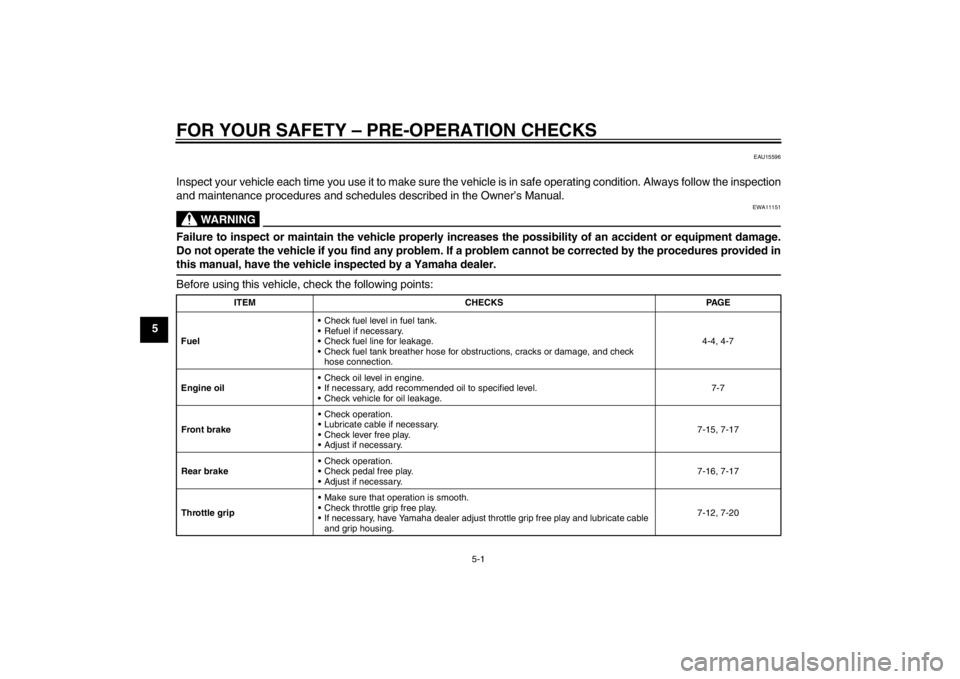
FOR YOUR SAFETY – PRE-OPERATION CHECKS
5-1
5
EAU15596
Inspect your vehicle each time you use it to make sure the vehicle is in safe operating condition. Always follow the inspection
and maintenance procedures and schedules described in the Owner’s Manual.
WARNING
EWA11151
Failure to inspect or maintain the vehicle properly increases the possibility of an accident or equipment damage.
Do not operate the vehicle if you find any problem. If a problem cannot be corrected by the procedures provided in
this manual, have the vehicle inspected by a Yamaha dealer.Before using this vehicle, check the following points:
ITEMCHECKS PAGE
Fuel Check fuel level in fuel tank.
Refuel if necessary.
Check fuel line for leakage.
Check fuel tank breather hose for obs
tructions, cracks or damage, and check
hose connection. 4-4, 4-7
Engine oil Check oil level in engine.
If necessary, add recommended oil to specified level.
Check vehicle for oil leakage. 7-7
Front brake Check operation.
Lubricate cable if necessary.
Check lever free play.
Adjust if necessary.
7-15, 7-17
Rear brake Check operation.
Check pedal free play.
Adjust if necessary. 7-16, 7-17
Throttle grip Make sure that operation is smooth.
Check throttle grip free play.
If necessary, have Yamaha dealer adjust throttle grip free play and lubricate cable
and grip housing. 7-12, 7-20
U2CJ80E0.book Page 1 Tuesday, June 12, 2012 11:15 AM
Page 42 of 86
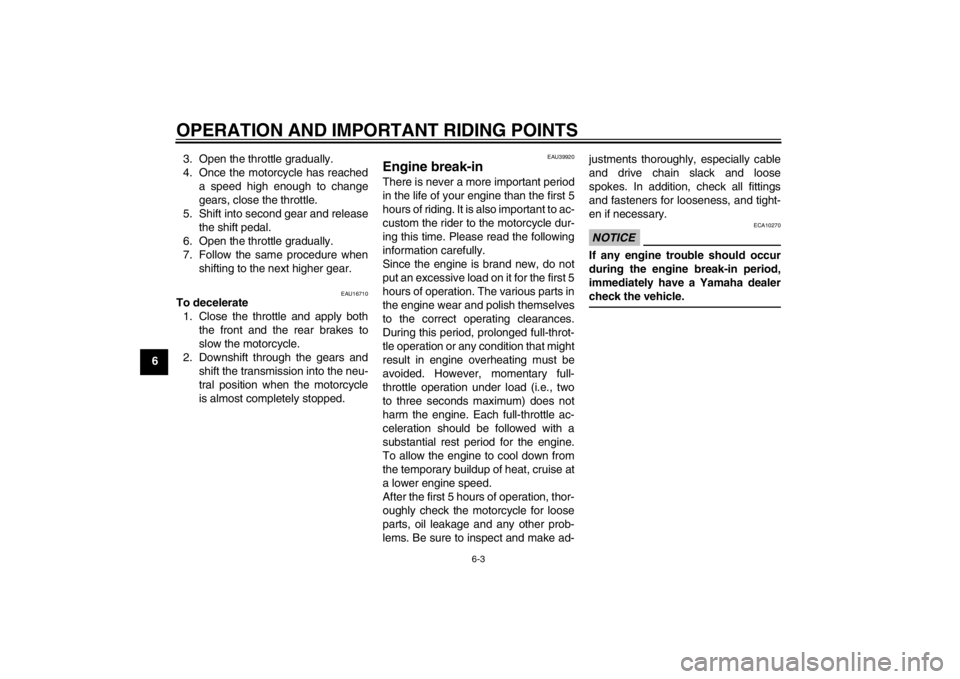
OPERATION AND IMPORTANT RIDING POINTS
6-3
63. Open the throttle gradually.
4. Once the motorcycle has reached
a speed high enough to change
gears, close the throttle.
5. Shift into second gear and release the shift pedal.
6. Open the throttle gradually.
7. Follow the same procedure when shifting to the next higher gear.
EAU16710
To decelerate1. Close the throttle and apply both the front and the rear brakes to
slow the motorcycle.
2. Downshift through the gears and shift the transmission into the neu-
tral position when the motorcycle
is almost completely stopped.
EAU39920
Engine break-in There is never a more important period
in the life of your engine than the first 5
hours of riding. It is also important to ac-
custom the rider to the motorcycle dur-
ing this time. Please read the following
information carefully.
Since the engine is brand new, do not
put an excessive load on it for the first 5
hours of operation. The various parts in
the engine wear and polish themselves
to the correct operating clearances.
During this period, prolonged full-throt-
tle operation or any condition that might
result in engine overheating must be
avoided. However, momentary full-
throttle operation under load (i.e., two
to three seconds maximum) does not
harm the engine. Each full-throttle ac-
celeration should be followed with a
substantial rest period for the engine.
To allow the engine to cool down from
the temporary buildup of heat, cruise at
a lower engine speed.
After the first 5 hours of operation, thor-
oughly check the motorcycle for loose
parts, oil leakage and any other prob-
lems. Be sure to inspect and make ad- justments thoroughly, especially cable
and drive chain slack and loose
spokes. In addition, check all fittings
and fasteners for looseness, and tight-
en if necessary.
NOTICE
ECA10270
If any engine trouble should occur
during the engine break-in period,
immediately have a Yamaha dealer
check the vehicle.
U2CJ80E0.book Page 3 Tuesday, June 12, 2012 11:15 AM
Page 45 of 86

PERIODIC MAINTENANCE AND ADJUSTMENT
7-2
7
EAU39944
Periodic maintenance chart for the emission control system TIP●
From 7000 km (4200 mi) or 18 months, repeat the maintenance intervals starting from 3000 km (1800 mi) or 6 months.
●
Items marked with an asterisk should be performed by a Yamaha dealer as they require special tools, data and technical
skills.
No.ITEM CHECKS AND MAINTENANCE JOBS INITIAL ODOMETER READINGS
1000 km
(600 mi) or
1 month or 30 hours 3000 km
(1800 mi) or
6 months or 90 hours 5000 km
(3000 mi) or
12 months or 150 hours
1 *Fuel line Check fuel hoses for cracks or damage.
Replace if necessary. √√
2 Spark plug Check condition.
Adjust gap and clean.
√√
3 *Valve clearance Check and adjust valve clearance when engine is cold. √
4 Air filter element Clean with solvent.
Replace if necessary. √√
5 *Crankcase breather sys-
tem Check ventilation hose for cracks or damage and drain
any deposits.
Replace if necessary. √√√
6 *Carburetor Check engine idling speed and starter operation.
Adjust if necessary.
√√√
7 Exhaust system Check for leakage.
Tighten if necessary.
Replace gasket(s) if necessary. √√
8 *Spark arrester Clean. √
9 Engine oil Change (warm engine before draining). √√√
U2CJ80E0.book Page 2 Tuesday, June 12, 2012 11:15 AM
Page 47 of 86

PERIODIC MAINTENANCE AND ADJUSTMENT
7-4
7
8Drive chain Check chain slack/alignment and condition.
Adjust and lubricate chain with Yamaha chain and cable
lube thoroughly. Every ride
9 *Steering bearings Check bearing assemblies for looseness.
Moderately repack with lithium-soap-based grease.
√√
10 *Chassis fasteners Check all chassis fitting and fasteners.
Correct if necessary. √√√
11 Brake lever pivot shaft Apply lithium-soap-based grease lightly. √√
12 Brake pedal pivot shaft Apply lithium-soap-based grease lightly. √√
13 Sidestand pivot Check operation.
Apply lithium-soap-based grease lightly. √√
14 *Front fork Check operation and for grease leakage.
Replace if necessary. √√
15 *Shock absorber assem-
bly Check operation and for oil leakage.
Replace if necessary.
√
16 *Control cables Apply Yamaha chain and cable lube or engine oil thor-
oughly. √√√
17 *Throttle grip Check operation.
Check throttle grip free play, and adjust if necessary.
Lubricate cable and grip housing. √√√
No. ITEM CHECKS AND MAINTENANCE JOBS
INITIAL ODOMETER READINGS
1000 km
(600 mi) or
1 month or 30 hours 3000 km
(1800 mi) or
6 months or 90 hours 5000 km
(3000 mi) or
12 months or 150 hours
U2CJ80E0.book Page 4 Tuesday, June 12, 2012 11:15 AM
Page 50 of 86

PERIODIC MAINTENANCE AND ADJUSTMENT
7-7
7To install the spark plug
1. Clean the surface of the spark plug gasket and its mating surface, and
then wipe off any grime from the
spark plug threads.
2. Install the spark plug with the spark plug wrench, and then tight-
en it to the specified torque.
TIPIf a torque wrench is not available when
installing a spark plug, a good estimate
of the correct torque is 1/4–1/2 turn
past finger tight. However, the spark
plug should be tightened to the speci-
fied torque as soon as possible.3. Install the spark plug cap.
EAU49932
Engine oil The engine oil level should be checked
before each ride. In addition, the oil
must be changed at the intervals spec-
ified in the periodic maintenance and
lubrication chart.
To check the engine oil level1. Place the motorcycle on a level surface and hold it in an upright po-
sition. A slight tilt to the side can re-
sult in a false reading.
2. Start the engine, warm it up for several minutes, and then turn it
off.
3. Wait a few minutes until the oil set- tles, remove the engine oil filler
cap, wipe the engine oil dipstick
clean, insert it back into the oil filler
hole (without screwing it in), and
then remove it again to check the
oil level.TIPThe engine oil should be between the
minimum and maximum level marks.
4. If the engine oil is at or below theminimum level mark, add sufficient
oil of the recommended type to
raise it to the correct level.
5. Insert the dipstick into the oil filler hole, and then tighten the oil filler
cap.
To change the engine oil 1. Start the engine, warm it up for several minutes, and then turn it
off.
2. Place an oil pan under the engine to collect the used oil.
Tightening torque:Spark plug:13 Nm (1.3 m·kgf, 9.4 ft·lbf)
1. Engine oil filler cap
2. Engine oil dipstick
3. Maximum level mark
4. Minimum level mark
U2CJ80E0.book Page 7 Tuesday, June 12, 2012 11:15 AM
Page 51 of 86

PERIODIC MAINTENANCE AND ADJUSTMENT
7-8
7
3. Remove the engine oil filler cap,
the engine oil drain bolt and its
gasket to drain the oil from the
crankcase.
4. Install a new gasket and the drain bolt, and then tighten the drain bolt
to the specified torque.
5. Refill with the specified amount of the recommended engine oil, and
then install and tighten the oil filler
cap.
NOTICE
ECA11620
●
In order to prevent clutch slip-
page (since the engine oil also
lubricates the clutch), do not
mix any chemical additives. Do
not use oils with a diesel speci-
fication of “CD” or oils of a high-
er quality than specified. In
addition, do not use oils labeled
“ENERGY CONSERVING II” or
higher.
●
Make sure that no foreign mate-
rial enters the crankcase.
6. Start the engine, and then let it idlefor several minutes while checking
it for oil leakage. If oil is leaking, im-
mediately turn the engine off and
check for the cause.
7. Turn the engine off, and then check the oil level and correct it if
necessary.
EAU39834
Cleaning the air filter element The air filter element should be cleaned
as follows at the intervals specified in
the periodic maintenance and lubrica-
tion chart. Clean or, if necessary, re-
place the air filter element more
frequently if you are riding in unusually
wet or dusty areas.
To clean the air filter element1. Remove the air filter case cover by removing the screws.
2. Pull the sponge material and the air filter mesh out.
1. Engine oil drain bolt
2. GasketTightening torque:Engine oil drain bolt:20 Nm (2.0 m·kgf, 14 ft·lbf)1
2
Recommended engine oil: See page 9-1.
Oil change quantity: 0.80 L (0.85 US qt, 0.70 Imp.qt)
1. Screw
2. Air filter case cover
U2CJ80E0.book Page 8 Tuesday, June 12, 2012 11:15 AM
Page 52 of 86
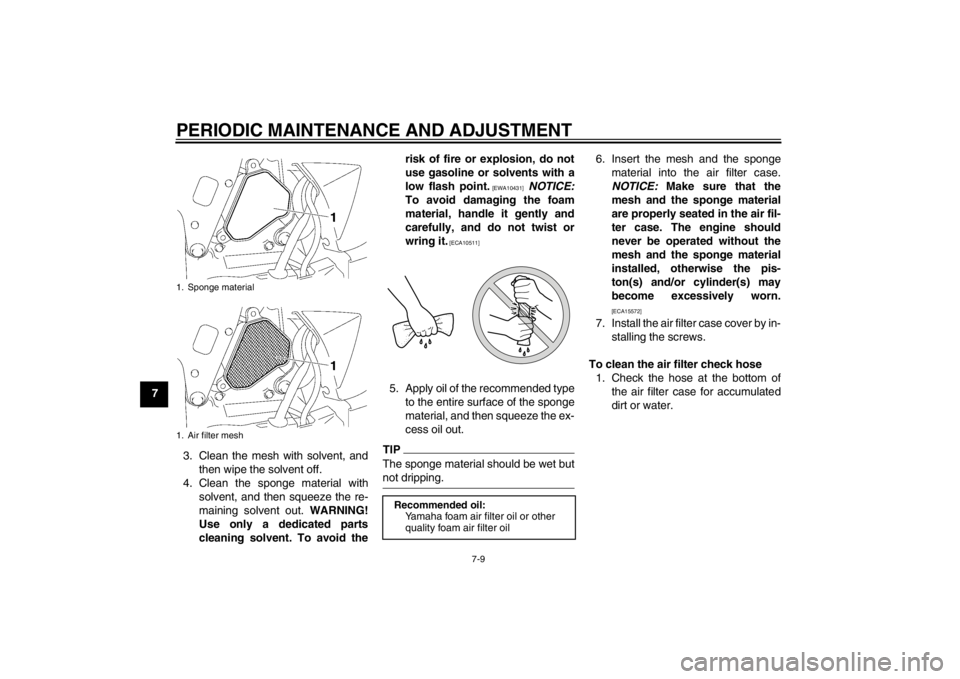
PERIODIC MAINTENANCE AND ADJUSTMENT
7-9
73. Clean the mesh with solvent, andthen wipe the solvent off.
4. Clean the sponge material with solvent, and then squeeze the re-
maining solvent out. WARNING!
Use only a dedicated parts
cleaning solvent. To avoid the risk of fire or explosion, do not
use gasoline or solvents with a
low flash point.
[EWA10431]
NOTICE:
To avoid damaging the foam
material, handle it gently and
carefully, and do not twist or
wring it.
[ECA10511]
5. Apply oil of the recommended type to the entire surface of the sponge
material, and then squeeze the ex-
cess oil out.TIPThe sponge material should be wet but
not dripping.
6. Insert the mesh and the spongematerial into the air filter case.
NOTICE: Make sure that the
mesh and the sponge material
are properly seated in the air fil-
ter case. The engine should
never be operated without the
mesh and the sponge material
installed, otherwise the pis-
ton(s) and/or cylinder(s) may
become excessively worn.
[ECA15572]
7. Install the air filter case cover by in- stalling the screws.
To clean the air filter check hose 1. Check the hose at the bottom of the air filter case for accumulated
dirt or water.
1. Sponge material
1. Air filter mesh
Recommended oil:Yamaha foam air filter oil or other
quality foam air filter oil
U2CJ80E0.book Page 9 Tuesday, June 12, 2012 11:15 AM
Page 63 of 86
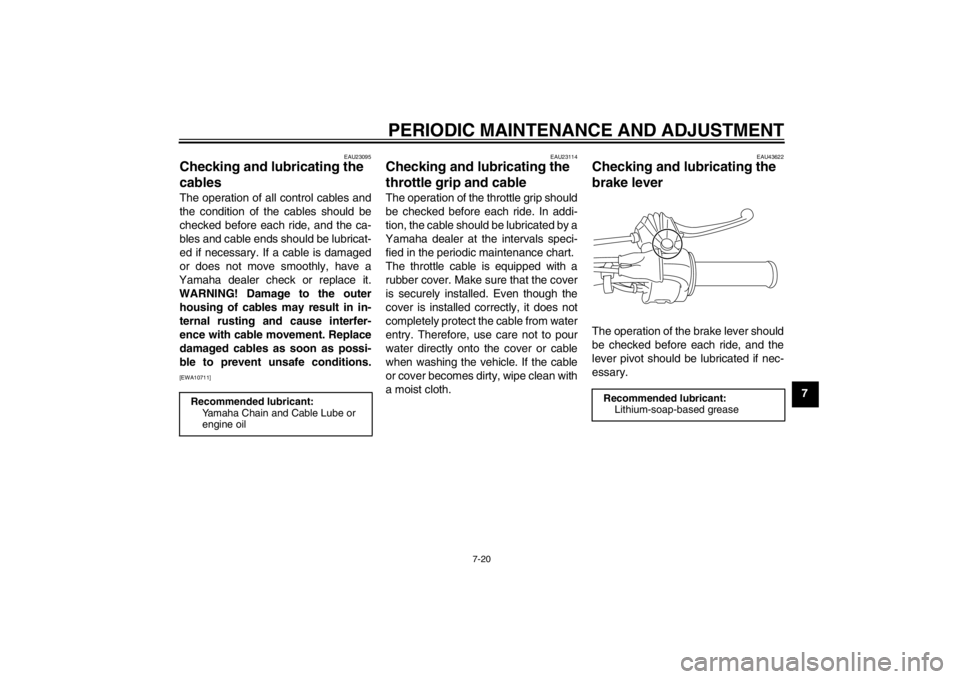
PERIODIC MAINTENANCE AND ADJUSTMENT
7-20
7
EAU23095
Checking and lubricating the
cables The operation of all control cables and
the condition of the cables should be
checked before each ride, and the ca-
bles and cable ends should be lubricat-
ed if necessary. If a cable is damaged
or does not move smoothly, have a
Yamaha dealer check or replace it.
WARNING! Damage to the outer housing of cables may result in in-
ternal rusting and cause interfer-
ence with cable movement. Replace
damaged cables as soon as possi-
ble to prevent unsafe conditions.[EWA10711] EAU23114
Checking and lubricating the
throttle grip and cable The operation of the throttle grip should
be checked before each ride. In addi-
tion, the cable should be lubricated by a
Yamaha dealer at the intervals speci-
fied in the periodic maintenance chart.
The throttle cable is equipped with a
rubber cover. Make sure that the cover
is securely installed. Even though the
cover is installed correctly, it does not
completely protect the cable from water
entry. Therefore, use care not to pour
water directly onto the cover or cable
when washing the vehicle. If the cable
or cover becomes dirty, wipe clean with
a moist cloth.
EAU43622
Checking and lubricating the
brake lever The operation of the brake lever should
be checked before each ride, and the
lever pivot should be lubricated if nec-
essary.
Recommended lubricant:
Yamaha Chain and Cable Lube or
engine oil
Recommended lubricant:Lithium-soap-based grease
U2CJ80E0.book Page 20 Tuesday, June 12, 2012 11:15 AM
Page 78 of 86
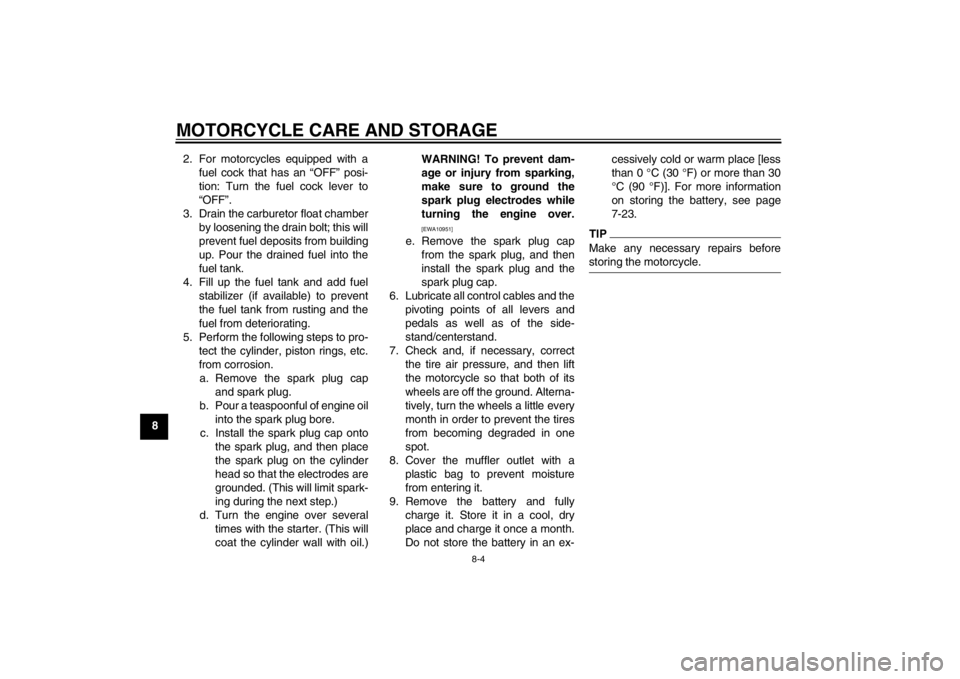
MOTORCYCLE CARE AND STORAGE
8-4
82. For motorcycles equipped with a
fuel cock that has an “OFF” posi-
tion: Turn the fuel cock lever to
“OFF”.
3. Drain the carburetor float chamber by loosening the drain bolt; this will
prevent fuel deposits from building
up. Pour the drained fuel into the
fuel tank.
4. Fill up the fuel tank and add fuel stabilizer (if available) to prevent
the fuel tank from rusting and the
fuel from deteriorating.
5. Perform the following steps to pro- tect the cylinder, piston rings, etc.
from corrosion.a. Remove the spark plug cap and spark plug.
b. Pour a teaspoonful of engine oil into the spark plug bore.
c. Install the spark plug cap onto the spark plug, and then place
the spark plug on the cylinder
head so that the electrodes are
grounded. (This will limit spark-
ing during the next step.)
d. Turn the engine over several times with the starter. (This will
coat the cylinder wall with oil.) WARNING! To prevent dam-
age or injury from sparking,
make sure to ground the
spark plug electrodes while
turning the engine over.
[EWA10951]
e. Remove the spark plug cap from the spark plug, and then
install the spark plug and the
spark plug cap.
6. Lubricate all control cables and the pivoting points of all levers and
pedals as well as of the side-
stand/centerstand.
7. Check and, if necessary, correct the tire air pressure, and then lift
the motorcycle so that both of its
wheels are off the ground. Alterna-
tively, turn the wheels a little every
month in order to prevent the tires
from becoming degraded in one
spot.
8. Cover the muffler outlet with a plastic bag to prevent moisture
from entering it.
9. Remove the battery and fully charge it. Store it in a cool, dry
place and charge it once a month.
Do not store the battery in an ex- cessively cold or warm place [less
than 0 °C (30 °F) or more than 30
°C (90 °F)]. For more information
on storing the battery, see page
7-23.
TIPMake any necessary repairs before
storing the motorcycle.
U2CJ80E0.book Page 4 Tuesday, June 12, 2012 11:15 AM